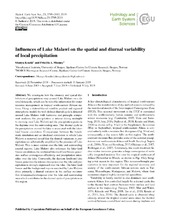Influences of Lake Malawi on the spatial and diurnal variability on local precipitation
Peer reviewed, Journal article
Published version

Åpne
Permanent lenke
https://hdl.handle.net/1956/23691Utgivelsesdato
2019Metadata
Vis full innførselSamlinger
- Geophysical Institute [1228]
Originalversjon
https://doi.org/10.5194/hess-23-2795-2019Sammendrag
We investigate how the intensity and spatial distribution of precipitation vary around Lake Malawi on a diurnal timescale, which can be valuable information for water resource management in tropical south-eastern African nations. Using a state-of-the-art satellite product and regional atmospheric model, the well-defined diurnal cycle is detected around Lake Malawi with harmonic and principle component analyses: the precipitation is intense during midnight to morning over Lake Malawi and the precipitation peaks in the daytime over the surrounding area. This diurnal cycle in the precipitation around the lake is associated with the lake–land breeze circulation. Comparisons between the benchmark simulation and an idealized simulation in which Lake Malawi is removed reveal that the diurnal variations in precipitation are substantially amplified by the presence of Lake Malawi. This is most evident over the lake and surrounding coastal regions. Lake Malawi also enhances the lake–land breeze circulation; the nocturnal lakeward land breeze generates surface convergence effectively and precipitation intensifies over the lake. Conversely, the daytime landward lake breeze generates the intense divergence over the lake and precipitation is strongly depressed over the lake. The lake–land breeze and the background vapour enriched by Lake Malawi drive primarily a diurnal variation in the surface moisture flux divergence/convergence over the lake and surrounding area which contributes to the diurnal cycle of precipitation in this region.
